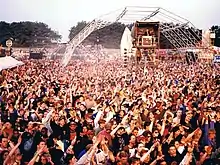Breakbeat hardcore
Breakbeat hardcore (also referred to as hardcore rave) is a music genre of the very early 1990s that spawned from the UK rave scene. It combines four-on-the-floor rhythms with breakbeats usually sampled from hip hop. In addition to the inclusion of breakbeats, the genre also features shuffled drum machine patterns, hoover and other noises originating from new beat, acid house squelches and bleeps, and often upbeat house piano riffs and vocals.[1]
| Breakbeat hardcore | |
|---|---|
| Stylistic origins | |
| Cultural origins | Late 1980s - early 1990s, United Kingdom |
| Derivative forms | |
Origins

The rave scene expanded rapidly in the very early 1990s, both at clubs up and down the country including Labrynth, Shelley's Laserdome, The Eclipse, and Sanctuary Music Arena, and large raves in warehouses and in the open air attracting 20–50,000 whether put on legally from promoters such as Fantazia and Raindance, or unlicensed by free party sound systems such as Spiral Tribe. Breakbeat hardcore drew its melting pot of sound from a vast array of influences - from the Belgian new beat sound that had for a short period been prominent in the UK rave scene, to house and acid house, and furthermore drawing on hip hop and reggae culture.[2][3]
Notable releases
Notable releases include:[4][5][6][7][8]
- "A Trip to Trumpton" - Urban Hype (Faze 2, 1992)
- "Baptised By Dub" - The Criminal Minds (White House, 1992)
- "Charly" / "Everybody in the Place" - The Prodigy (XL Recordings, 1992)
- "Close Your Eyes" / "Trip II the Moon" - Acen (Production House Records, 1992)
- "Cookin Up Yah Brain" - 4hero (Reinforced Records, 1992)
- "DJ's Take Control" / "On a Ragga Tip" - SL2 (XL Recordings, 1992)
- "Far Out" - Sonz of a Loop Da Loop Era (Suburban Base, 1991)
- "Frequency" - Altern-8 (Network Records, 1991)
- "Help Me" - Sly T & Ollie J (Blackmarket, 1992)
- "Homicide" / "Exorcist" / "Frequency" - Shades of Rhythm (ZTT Records, 1991)
- "Hurt You So" - Jonny L (Yoyo, 1992)
- "I Feel Love" - Messiah (Kickin Records, 1992)
- "Let Me Be Your Fantasy" - Baby D (Production House, 1992)
- "NHS (Disco Remix)" - Doc Scott (Absolute 2, 1992)
- "Sesame's Treet" - Smart E's (Suburban Base/Atlantic, 1992)
- "Set You Free" - N-Trance (All Around the World, 1992)
- "Some Justice" - Urban Shakedown (Urban Shakedown, 1992)
- "Spliffhead" / "Hooligan 69" - Ragga Twins (SUAD Records, 1991)
- "Summers Magic" - Mark Summers (4th & Broadway, 1990)
- "Sweet Harmony" - Liquid (XL Recordings, 1992)
- "The Bouncer" - Kicks Like a Mule (Tribal Base, 1992)
- "The Green Man" / "Raving I'm Raving" - Shut Up and Dance (SUAD Records, 1992)
- "The Wickedest Sound" - Rebel MC (Desire, 1991)
- "Trip II the Moon"/"Trip II the Moon (Part 2)" - Acen (Production House, 1992)
- "Waremouse" / "Bombscare" - 2 Bad Mice (Moving Shadow, 1992)
Fragmentation
By late 1992, breakbeat hardcore started to fragment into a number of subsequent genres: darkcore (piano rolls giving way to dark-themed samples and stabs), hardcore jungle (where reggae basslines and samples became prominent), and happy hardcore (retaining piano rolls and more uplifting vocals).[9]
References
- Reynolds, Simon (1998). Energy Flash: A Journey Through Rave Music and Dance Culture. Picador.
1990 also saw the genesis of a distinctively British rave sound, 'hard core', which decisively broke with the mould of Detroit and Chicago, and ended the dependency on American imports. By 1991 this underground sound - actually a confederacy of hybrid genres and regional styles - was assaulting the mainstream pop charts.
- Reynolds, Simon (1998). Energy Flash: A Journey Through Rave Music and Dance Culture. Picador.
Influenced by reggae and hip hop, hardcore producers intensified the sub-bass frequencies, used looped breakbeats to funk up house's four-to-the-floor machine-beat, and embraced sampling with deranged glee. Following the lead of the bombastic Belgians and Germans, UK producers deployed riff-like 'stabs' and bursts of glaring noise.
- Reynolds, Simon (1998). Energy Flash: A Journey Through Rave Music and Dance Culture. Picador.
Between 1990 and 1993, hardcore in Britain referred by turns to the Northern bleep-and-bass sound of Warp and Unique 3, to the hip-house and ragga-techno sounds of the Shut Up And Dance label, to the anthemic pop-rave of acts like N-Joi and Shades of Rhythm, to Belgian and German brutalist techno, and, finally to the breakbeat-driven furore of hardcore jungle.
- "20 best: Hardcore records ever made". FACTmag. 3 June 2012.
- "The 10 best rave tracks, according to 2 Bad Mice". Dummy Mag. 2 June 2016.
- "The 50 greatest rave anthems of all time". Four Four.
- "10 great lost rave anthems". RBMA. 23 May 2019.
- "10 ultimate rave anthems chosen by acid house heroes Altern-8". DJMag. 24 August 2018.
- Reynolds, Simon (1998). Energy Flash: A Journey Through Rave Music and Dance Culture. Picador.
Back in 1993, when hardcore plunged into the 'darkside', a breakaway faction of DJ-producers like Seduction, Vibes and Slipmatt continued to make celebratory, upful tunes based around hectic breakbeats. By the end of 1994, happy hardcore had coalesced into a scene that operated in parallel with its estranged cousin, jungle.
Further reading
- Simon Reynolds, Energy Flash: a Journey Through Rave Music and Dance Culture, Picador 1998 (ISBN 0-330-35056-0)